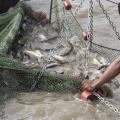Catfish Marketing
Processors
The number of catfish processing facilities has varied over time as processing plants have been built, closed, restarted, and sold. Since a peak of catfish processing companies in 1990, the number of processors has fluctuated between 18 and 28 processors. In 2016, there were 12 major processors in the southeastern United States with several plants with capacities greater than 50 million pounds/year. These, combined with the medium and small facilities, processed over 315 million pounds of liveweight catfish in 2015.
Processors generally deal with many wholesale or retail customers, and they thus have a market for different sized fish. For this reason, processors will generally allow more latitude in the size distribution of fish than may be permissible through some other market outlets. A final advantage of selling to a processor is that the processor bears the majority of the liability for any problems related to product safety or quality.
Of course, selling to a processor is not without its disadvantages. The primary disadvantage is that the producer is a price taker. That is, the producer has very little ability to try to negotiate a higher price with the processor. This situation is common to most producers of agricultural commodities. It is also worth noting that a producer is not guaranteed to be able to sell to a processor at any given time. Processors do generally handle a large volume of fish, but from time to time, even large processors may not need to make additional purchases.
Given the weak bargaining position, it is to the producer's advantage to have as much information about regional processors' operational characteristics. Key information would include:
- historical prices paid for fish from the plant as compared to other plants;
- dockage rates (poundage or percentage deducted from the total delivery amount) for non-target fish, out-of-size fish, or other reasons;
- required stock purchases and/or billbacks;
- transportation charges;
- payment frequency to growers and typical length of time between the time of delivery of fish and receipt of payment;
- seasonality issues;
- delivery volume requirements;
- fish size requirements;
- quality standards and checks;
- delivery quotas and scheduling patterns; and
- state bonding requirements.
Direct Sales
The primary alternative to selling to processors is to market directly to a customer further down the marketing chain. Producers may try to establish direct sales outlets with wholesalers, retailers (e.g., local grocers or restaurants), or final consumers. The primary advantage of direct selling is that it is potentially a high-margin activity. In direct selling, the producer captures all or a large portion of the marketing margin. But direct selling is not necessarily easy. It may be difficult for an individual producer to establish business relationships with wholesalers, grocers, or restaurants. Moreover, these direct sales outlets may have very strict requirements for their suppliers.
Another issue to consider is that direct sales to local grocery stores and restaurants will probably require on-site processing unless restaurant personnel clean the fish. The ability to process fish on-site will likely require the producer to have a functioning Hazard Analysis, Critical Control Points (HACCP) plan in place. In direct selling, the producer assumes a great deal more liability for product safety or quality problems than in selling to a processor. The major problem with direct sales to consumers is that this is typically a very low volume market outlet.
Consumer Demand and Preference
The per capita consumption of all fish and seafood in the United States continues to decrease from its high of 16.3 pounds per capita in 2003. In 2013, United States consumers ate 14.5 pounds per person. Catfish was the eighth most consumed fish item at 0.566 pounds per capita.
An important aspect of consumer preference relates to product form. Farm-raised catfish is available in any of these general forms:
- Whole Dressed (fresh)
- Steaks (cross-section cuts from larger dressed fish, fresh or frozen)
- Fillets (boned sides of the fish, cut lengthwise away from the backbone, fresh or frozen)
- Regular and shank fillets (regular fillets have the belly section attached, shank fillets have the belly section removed, fresh or frozen)
- Nuggets (boneless pieces cut from the belly section of the fillet, fresh or frozen)
- Strips and fingers (smaller pieces of fish cut from fillets, fresh or frozen)
- A variety of prepared forms including breaded, marinated, or Delacata® Style Catfish Fillets.
Processors have responded to consumer preference by producing 60 to 70 percent fillets, 10 to 15 percent whole-dressed fish, 10 to 15 percent nuggets, and 10 to 15 percent value-added breaded, marinated, or strip/finger products.
Frozen fillet products have had the greatest increase both in volume and in sales. Processors sell approximately 50 percent of frozen product to distributors, 30 percent to national restaurant chains, and 20 percent to direct end users. Frozen products consist mainly of fillets, strips (from the whole fillet), or nuggets. Approximately 80 percent of fresh catfish products go to retail grocery stores or supermarket chains and the remainder to chain restaurants. Fresh catfish sold to retail groceries are usually in whole dressed, fillet, or nugget form.
Other Catfish Marketing Information
Nutritional Benefits of Seafood
https://srac.tamu.edu/serveFactSheet/255
You Can Do Catfish
https://srac.tamu.edu/serveFactSheet/136
Farm-Raised Channel Catfish (Consumer Information Series)
https://srac.tamu.edu/serveFactSheet/265
Small-Scale Marketing of Aquaculture Products
https://srac.tamu.edu/serveFactSheet/64
Small Scale, On-farm Fish Processing
https://srac.tamu.edu/serveFactSheet/101
Processing Channel Catfish
https://srac.tamu.edu/serveFactSheet/25
Processed Catfish: Product Forms, Packaging, Yields and Product Mix
https://srac.tamu.edu/serveFactSheet/26
Analysis of Regional and National Markets for Aquacultural Products
Produced for Food in the Southern Region
https://srac.tamu.edu/serveFactSheet/139
Small-Scale Marketing of Aquaculture Products
https://srac.tamu.edu/serveFactSheet/64
The HACCP Seafood Program and Aquaculture
https://srac.tamu.edu/serveFactSheet/173
USDA NASS Catfish Processing
http://www.nass.usda.gov/Surveys/Guide_to_NASS_Surveys/Catfish_Processing/index.php
The Catfish Institute
http://uscatfish.com/
News
STARKVILLE, Miss. -- Lower feed prices are providing some relief to Mississippi’s catfish producers, but many are still facing more than their share of obstacles just to break even.



